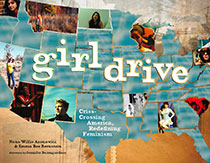Fred just happens to be Frederic Jameson, one of the most influential theorists of postmodernity.

By Nona Willis Aronowitz and Emma Bee Bernstein; Seal Press; 221 pages
Some years ago, I was waiting for a colleague as she finished her last student conference of the day. She was teaching a class on gender and a student had come to discuss paper topics. “I’d like to look at some sexist histories,” the young woman said, with great assurance. I could not help but turn sharply in my squeaky wooden chair, just in time to see the bemused expression on my colleague’s face as she asked, “Um, do you mean feminist histories?” “Oh, yeah, right, I guess I meant feminist,” came the cheerful answer.
That inability to distinguish between feminism and sexism is unsurprising in a world where Republicans denounce anyone critical of Sarah Palin’s vacuousness as sexist and where Hillary Clinton’s career, forged under the aegis of a successful husband, is seen as a feminist triumph. In all this topsy-turviness, is it any surprise that some can barely distinguish feminism from its opposite?
In the fall of 2007, Nona Willis Aronowitz and Emma Bee Bernstein, both in their mid-20s, got into a car and spent a good portion of the season and spring 2008 crisscrossing the country and talking to women about the meaning of feminism. They spoke to 127 women involved in fields like sex work, abortion-provider services and Native American rights activism.
Girldrive: Criss-Crossing America, Redefining Feminism took Willis Aronowitz and Bernstein to places as different as Jackson Hole, Miss., and Chicago. The book reveals American feminism as contradictory and richly complex. Willis-Aronowitz and Bernstein, diehard progressives, don’t shy away from women like Beth in Fargo, N.D., who tells them that she believes in equality in the workplace but also that “[t]here are definitely roles for a husband and a wife, and feminism would be erasing that.” On the other end of the spectrum is Rebecca, who runs Pantymistress, a porn-production company for men with fetishes.
Girldrive boasts of its diversity because the two went to a number of cities and the photographs of their subjects, taken by Bernstein, indicate a rich mix of heritages, from Chicana to Creole to Anglo. But the differences in hues of skin and ethnic lineages cannot hide the fact that underlying the surface diversity is much of the same-old, same-old.
If you live in a hipster bubble in a liberal hotspot like Austin, Texas, or Chicago, you will recognize these women. Their feminist credentials are first earned in a liberal arts college or university; they take their degrees to an enterprising non-profit devoted to some form of social justice; and they support queer, sex- and fat-positive politics.
The women are no less interesting for these reasons. And while some of us might, indeed, strongly identify as and with them, I suspect that they are entirely new to most Americans who cannot fathom a discussion about feminism beyond the standard “Should women work after having children?” question.
Yet, it becomes clear that the two women rarely ventured outside their socioeconomic backgrounds. Entries are often prefaced with phrases like, “Cille …a friend of my best friend,” indicating that they rarely reached out of their network of friends or like-minded blogosphere of supporters (the book originally began as a blog, and was featured on sites like Feministing) . Bernstein, who committed suicide in December 2008, graduated from the University of Chicago and was the daughter of the artist Susan Bee and the writer Charles Bernstein. Willis Aronowitz, who wrote much of the book, graduated from Wesleyan and is the daughter of the Second Wave feminist Ellen Willis, who died in 2006, and the cultural critic Stanley Aronowitz. Driving through North Carolina, they spend the night at the house of Fred, an old family friend of Willis Aronowitz. Fred just happens to be Frederic Jameson, one of the most influential theorists of postmodernity.
Despite Willis Aronowitz’s attempt to make them seem like two wide-eyed innocents who stumble into interviews like one with Erica Jong, it is clear that the duo benefited greatly from their social connections and enormous cultural capital. That is not in itself a bad thing—every writer makes do with the resources at hand—but they could have used all that as a base from which to expand their pool of interviewees and to let happenstance dictate more of their agendas. At one point, they run into a single female bartender with a child and on welfare, unsure if she can finish a degree in anthropology (the value of which she now doubts) and angry about being treated like “a vagina behind the bar.” The authors do not even get her name, but more stories like hers could have complicated their journey in a good way.
In another rare trenchant moment, the poet Lyn Hejinian conveys her distrust of relying on social-networking sites and blogs to stimulate feminism because they can “lead to false senses of community and obsession with faking a caricatured self-image,” but the authors simply dismiss her critique, putting it down to an unwillingness to “communicate that way.” Yet, surely, face-to-face organizing and community-building is doubly important for women who do not have access to the urban areas that the pair choose to focus on.
Girldrive gives a sense of a certain kind of feminism in America today, one that mirrors the privileged experiences of the writers rather than challenging their or their intended audience’s assumptions. But if feminism is to survive to the point where women understand its value and the distinction between it and sexism, we have to be willing to record far more uncomfortable realities than our own.